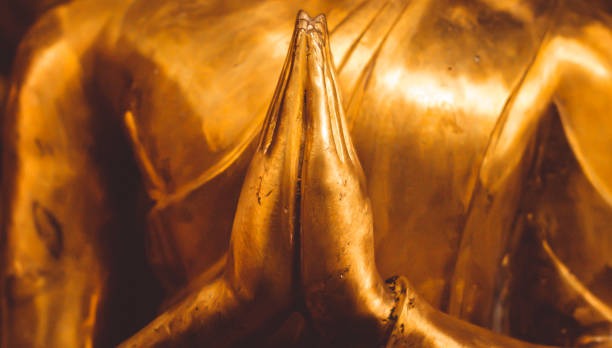Pranam, Namaskar, Namaste : The Sacred Art of Salutation in Sanatan Dharma

In a world dominated by hurried Hellos and rushed Handshakes, India’s ancient spiritual tradition offers timeless forms of greeting - Pranam, Namaskar, and Namaste. More than just words, these salutations are acts of reverence, portals to humility, and reminders of the divine in each one of us.
"When the greeting becomes a prayer, the person becomes a presence." ~ Adarsh Singh
Let us delve into their meanings, scriptural roots, and spiritual essence.
Pranam ~ The Bow of Surrender
Meaning and Etymology:
‘Pranam’ comes from the Sanskrit:
Pra- (forth) + Nam (to bow) = "to bow down in deep reverence or submission."
It is an act of complete surrender, often involving a full-body prostration, used to show utmost respect to elders, gurus, or the Divine.
Scriptural Reference – Bhagavad Gita (11.44):
Sanskrit:
तस्मात्प्रणम्य प्रणिधाय कायं
प्रसादये त्वामहमीशं ईड्यम्।
पितेव पुत्रस्य सखेव सख्युः
प्रियः प्रियायार्हसि देव सोढुम्॥
Transliteration:
Tasmāt praṇamya praṇidhāya kāyaṁ prasādaye tvām aham īśam īḍyam
Piteva putrasya sakheva sakhyuḥ priyaḥ priyāyārhasi deva soḍhum
Meaning:
"Therefore, bowing down and prostrating my body, I seek to please You, O Lord, who are worthy of all worship..."
This verse from Arjuna is not just poetic, it reflects total submission of ego before truth.
"In Pranam, the body bows, the mind silences, and the soul awakens." ~ Adarsh Singh
Namaskar ~ The Salutation of Respect
Meaning and Etymology:
Namaskar is derived from:
Namah (salutation) + Kara (doing/action) = "the act of bowing or paying respect."
Namaskar is often used in formal greetings, during pujas, or while addressing audiences with dignity.
Scriptural Reference - Taittiriya Aranyaka (10.23.1):
Sanskrit:
नमः शम्भवाय च मयोभवाय च।
नमः शङ्कराय च मयस्कराय च।
नमः शिवाय च शिवतराय च॥
Transliteration:
Namaḥ Śambhavāya ca Mayobhavāya ca
Namaḥ Śaṅkarāya ca Mayaskarāya ca
Namaḥ Śivāya ca Śivatarāya ca
Meaning:
"Salutations to Śambhu, Mayobhava, Śankara, and the most auspicious Śiva."
Here, Namaskar is used as a sacred act of acknowledging divine manifestations, showing how greeting becomes devotion.
"Namaskar is not about meeting a person; it is about meeting the divine potential within them." ~ Adarsh Singh
Namaste ~ The Greeting of the Soul
Meaning and Etymology:
Namaste = Namah (bow) + Te (to you) = "I bow to you."
This gesture recognizes that the Divine resides in all beings.
Commonly used in daily interactions, yoga practices, and spiritual communities, Namaste bridges the material with the spiritual.
Scriptural Reference - Rigveda (10.85.23):
Sanskrit:
नमस्ते अस्तु भगवन् विश्वेश्वराय महादेवाय त्र्यम्बकाय।
त्रिपुरान्तकाय त्रिकाग्निकालाय कालाग्निरुद्राय नीलकण्ठाय मृत्युंजयाय॥
Transliteration:
Namaste astu Bhagavan Viśveśvarāya Mahādevāya Tryambakāya,
Tripurāntakāya Trikāgnikālāya Kālāgnirudrāya Nīlakaṇṭhāya Mṛtyuñjayāya
Meaning:
"Salutations to You, O Lord of the Universe, the great God, the three-eyed One, the destroyer of Tripura..."
Even the Vedas use Namaste as a divine invocation, a reminder that every person is a reflection of the cosmos.
"When I say Namaste, I am not greeting you; I am bowing to the part of God that lives in you." ~ Adarsh Singh
Comparison Summary
Although Pranam, Namaskar, and Namaste are often used interchangeably in modern contexts, each carries its own distinct meaning, purpose, and usage.
Pranam is the most intense and devoted form of salutation. It signifies complete surrender, involving full-body prostration or bowing, often directed toward elders, gurus, or the Divine. It is rooted in deep reverence and humility, symbolizing the dissolution of ego before higher wisdom or divine presence. This is beautifully illustrated in Bhagavad Gita 11.44, where Arjuna prostrates himself before Lord Krishna in awe and surrender.
Namaskar, on the other hand, is a more formal and respectful greeting. Derived from the act of performing "namah" or salutation, it often involves joining the palms and bowing slightly. It is commonly used in rituals, cultural interactions, and respectful social greetings. The Taittiriya Aranyaka (10.23.1) contains multiple verses beginning with "namah," offering salutations to various divine forms, showing its significance in Vedic worship and ceremony.
Namaste is the most universally known and widely used among the three, particularly in yoga and spiritual communities. It literally means “I bow to you,” with the deeper implication being “I bow to the Divine within you.” The palms joined at the heart center and a slight bow symbolize acknowledgment of the inner divinity in every being. It finds resonance in Rigveda 10.85.23, where even deities are greeted with “Namaste”, emphasizing its spiritual potency.
Thus, while Pranam represents deep surrender and reverence, Namaskar signifies formal respect and cultural acknowledgment, and Namaste symbolizes the recognition of universal divinity within all beings. Together, they form a spiritual continuum of reverence, from surrender to respect to soulful connection.
Pranam, Namaskar, and Namaste are not mere cultural formalities. They are tools of spiritual alignment, expressions of reverence, and gateways to deeper consciousness. They remind us that every interaction is an opportunity to acknowledge the divine in and around us.
"A civilization is not measured by its technology but by how it greets the soul in another." ~ Adarsh Singh
Mon May 5, 2025
